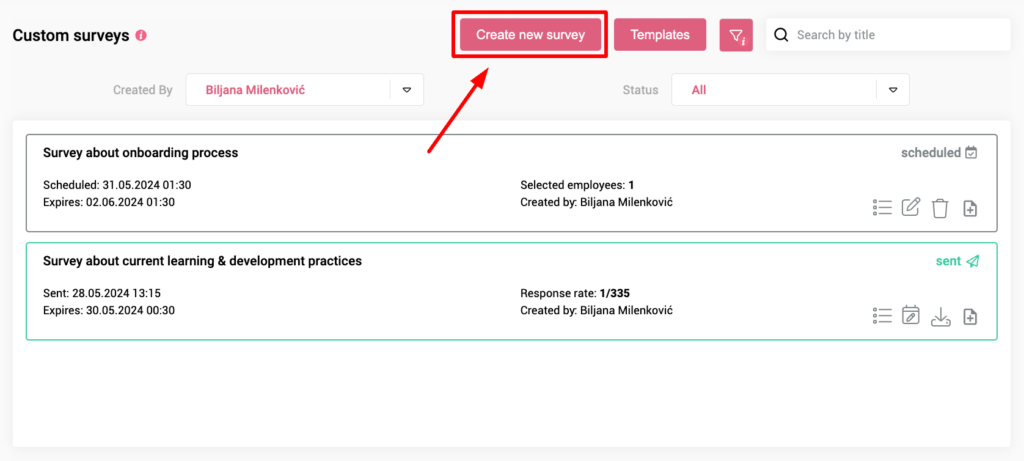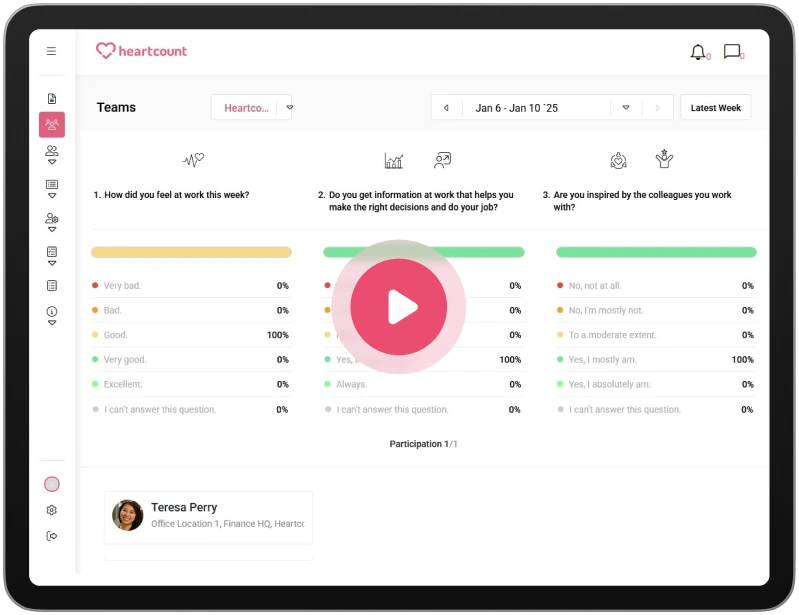Employee attitude: What is it and how it affects workplace culture

Employee attitude is contagious. A bad one can infect an entire workplace.
New hires arrive full of enthusiasm, ready to make a positive impact. However, an employee with bad attitude can quickly dampen that spirit with constant negativity. They can distort the company’s image, focusing on the negative while overshadowing the positives.
A negative working environment is demotivating and leads to reduced productivity and increased turnover. Moreover, a toxic coworker can create a hostile subculture, making it difficult for new hires to integrate and feel welcomed.
Harsh true: bad attitudes cost money, and the abovementioned are just some of the consequences. Let’s talk about it.
-
1.What is employee attitude and why it matters
-
2.How to recognize an employee with a bad attitude
-
3.Characteristics of a positive employee attitude
-
4.Factors influencing employee attitudes
-
5.Dealing with an employee’s negative attitude
-
6.Don’t overlook employees with a positive attitude
-
7.How to create a positive attitude in the workplace
-
8.Employee attitude: Take charge of it
Employee attitude is contagious. A bad one can infect an entire workplace.
New hires arrive full of enthusiasm, ready to make a positive impact. However, an employee with bad attitude can quickly dampen that spirit with constant negativity. They can distort the company’s image, focusing on the negative while overshadowing the positives.
A negative working environment is demotivating and leads to reduced productivity and increased turnover. Moreover, a toxic coworker can create a hostile subculture, making it difficult for new hires to integrate and feel welcomed.
Harsh true: bad attitudes cost money, and the abovementioned are just some of the consequences. Let’s talk about it.
What is employee attitude and why it matters
Employee attitude refers to the mental state or disposition an individual brings to work. It includes their feelings, beliefs, and values about their job, colleagues, and the organization as a whole. This mindset can be positive, negative, or neutral and significantly influences their behaviour and performance.
Employee attitude is the foundation of organizational success. As Simon Sinek, a business leadership author, states: “You don’t hire for skills, you hire for attitude. You can always teach skills.” Indeed, a positive attitude creates a productive, collaborative, and innovative work environment. Conversely, a negative attitude can create a toxic culture that hampers productivity and leads to high turnover.
Attitude impacts all important aspects of employee engagement:
- Productivity: Employees with a positive attitude are more motivated, engaged, and focused. They are also more efficient, make fewer errors, and go the extra mile. Conversely, negative attitudes can lead to procrastination, absenteeism, and decreased output.
- Employee morale: A positive attitude can uplift the atmosphere, creating a supportive and enjoyable work environment. Conversely, negative attitudes can dampen morale, leading to feelings of dissatisfaction and burnout.
- Teamwork: Positive attitudes facilitate collaboration, trust, and open communication. Employees with a positive outlook are likelier to be team players and contribute to a holistic work environment. Negative attitudes can create friction, hinder teamwork, and lead to conflicts.
Recognizing the signs of a negative attitude is necessary for addressing the issue proactively. Some common indicators that an employee is unhappy at work include:
- Decreased productivity and quality of work
- Increased absenteeism and tardiness
- Negative body language and communication
- Complaining and blaming others
- Lack of enthusiasm and motivation
- Difficulty getting along with colleagues
- Resistance to change
How to recognize an employee with a bad attitude
Identifying employees with a negative attitude can be challenging, as these individuals often mask their feelings.
However, several techniques can help you uncover potential issues:
Regular pulse checks
Pulse check surveys are short, frequent surveys that help you determine employee sentiment. By regularly checking in with employees, you can identify emerging issues or declining morale before they escalate.
Consistent low ratings on job satisfaction, work environment, or management questions indicate a negative attitude. Also, an uptick in complaints or criticisms about the company, workload, or colleagues signals dissatisfaction.
Custom surveys
Custom employee satisfaction surveys are tailored questionnaires designed to gather specific information about employee sentiment, engagement, and workplace culture.
Targeted questions about job stress, workload, colleague relationships, or management reveal negative sentiments. Qualitative data from open-ended questions can provide valuable insights into employees’ frustrations and concerns.
Employee Net Promoter Score (eNPS)
eNPS is a metric that measures customer loyalty and advocacy. By understanding how likely employees are to recommend the company as a great place to work, you can identify potential areas of dissatisfaction.
A consistently low eNPS suggests employees are unlikely to recommend the company, which can indicate negative sentiment. Additional employee comments provide more specific information about their dissatisfaction.
Stay interviews
Stay interviews uncover the factors that drive employee retention but also serve as early warning systems for potential turnover. By understanding what keeps employees engaged, you can identify emerging issues that impact morale and job satisfaction.
Employees often share candid feedback during stay interviews about job aspects that negatively affect their outlook. These include limited growth opportunities, poor work-life balance, or strained relationships with colleagues or management. Such insights provide crucial clues about potential risks to employee retention.
Performance reviews
While primarily focused on performance, these reviews can also provide insights into employee attitudes and motivation. A decline in performance metrics can be a symptom of a negative attitude, as employees may be less motivated or engaged.
Observation
Observing employees in their daily work can reveal signs of bad attitudes.
For example:
- Negative body language: Signs like crossed arms, eye-rolling, or avoiding interaction can indicate a negative attitude.
- Decreased engagement: Reduced participation in team activities or a lack of enthusiasm can be a warning sign.
- Increased conflict: Frequent disagreements or arguments with colleagues can signal a hostile and confrontational attitude.
Peer feedback
Peer feedback can offer valuable insights into how employees interact with each other and identify potential issues. If peers mention the employee is withdrawn or avoids interaction, it could indicate a negative attitude.
Social media monitoring
Tracking employee activity on social media platforms can provide clues about employee sentiment and engagement, but you should do it ethically and cautiously.
Public complaints or criticisms on social media can indicate underlying issues. Also, declining interactions with company-related posts can suggest a lack of enthusiasm or connection to the organization.
Note: Combine these methods to get a comprehensive picture of employee attitudes. By proactively addressing negative attitudes, you can create a healthier work atmosphere and improve overall employee satisfaction.
Characteristics of a positive employee attitude
Employees with positive attitudes are invaluable assets to any organization. They contribute to a healthy work environment and drive overall success.
Here are some key characteristics of these individuals:
- Optimism: They see challenges as opportunities for growth.
- Resilience: They bounce back quickly from disappointments and failures.
- Enthusiasm: They bring a contagious energy to the workplace.
- Passion: They are genuinely interested in their roles and responsibilities.
- Support: They are willing to help others succeed.
- Open-mindedness: They are receptive to input from others.
- Proactivity: They identify issues and seek solutions.
- Ownership: They take responsibility for their work and outcomes.
- Adaptability: They embrace new ideas and processes.
- Willingness to learn: They are eager to acquire new skills and knowledge.
- Dedication: They are committed to their roles and responsibilities.
- Reliability: They are dependable and consistent in their performance.
- Clear communication: They express themselves clearly and concisely.
- Active listening: They pay attention to others and value their input.
Employees with these characteristics create a positive ripple effect throughout the organization, inspiring others and contributing to overall success.
Factors influencing employee attitudes
Understanding factors that shape employee attitudes helps create a positive work environment and enhances employee engagement.
1. Work environment
The physical and psychological surroundings where employees work significantly impact their attitude. A comfortable, safe, and well-equipped workspace boosts morale, productivity and innovation. On the other hand, a noisy, cramped, or hazardous environment can lead to stress, dissatisfaction, and decreased job performance.
2. Leadership and management style
Leaders’ and managers’ attitudes are examples for the entire organization. Their behaviour, communication style, and decision-making process directly influence employee attitudes.
Supportive, inspiring leaders who foster trust and open communication create a positive work environment.
Conversely, micromanaging or authoritarian leadership can demotivate employees and lead to negative attitudes.
3. Job satisfaction
How employees feel about their work directly affects their attitude. Factors like job content, challenges, opportunities for growth, and recognition contribute to job satisfaction. Employees who enjoy their work and feel valued are more likely to have a positive attitude.
4. Compensation and benefits
Fair and competitive pay, along with comprehensive benefits packages, are crucial for employee satisfaction. Financial security and well-being are essential for positive attitudes. However, even with good compensation, other factors like job satisfaction and work-life balance also play a significant role.
5. Work-life balance
When people feel overwhelmed by work and have little time for personal commitments, their job satisfaction and overall well-being decline, as well as employee attitude. If this feeling is prolonged for too long, eventually, they’re starting to show clear signs of unhappiness.
Organizations that support work-life balance through flexible hours, remote work options, and wellness programs cultivate positive employee attitudes.
6. Company culture
Company culture reflects an organization’s values, beliefs, and behaviours. A constructive and welcoming culture creates a sense of belonging and camaraderie among employees.
Open communication, teamwork, and shared goals contribute to a positive work environment. Conversely, a toxic culture with negative behaviours and a lack of support can harm employee morale and productivity, leading to bad attitudes.
7. Career development opportunities
Employees who see opportunities for growth within a company are more likely to be engaged and satisfied.
Providing training, mentorship, and clear career paths helps employees develop their skills and feel valued. Lack of development opportunities can lead to boredom, frustration, and a negative attitude.
8. Recognition and reward systems
Acknowledging and rewarding employees’ contributions is essential for motivation and job satisfaction.
Public recognition, performance bonuses, and other incentives increase employee morale and engagement.
However, rewards must be fair, consistent, and aligned with organizational goals to be effective.
9. Job security
Feeling secure in one’s job is crucial for employee well-being and attitude. Economic uncertainty and fear of job loss can create stress and anxiety, negatively impacting performance.
Clear communication about the company’s financial health and job security measures can help alleviate employee concerns.
10. Peer relationships
Positive relationships with colleagues contribute to job satisfaction and overall morale. A supportive and collaborative work environment fosters teamwork and cooperation. Conversely, conflicts and negative interactions among colleagues can create a stressful and unproductive work atmosphere.
Dealing with an employee’s negative attitude
A negative employee can cast a long shadow over an entire team, impacting morale, productivity, and overall job satisfaction.
According to Gallup’s study, 59% are disengaged in their roles, a phenomenon often referred to as “quiet quitting.” Additionally, 18% are “loud quitting,” meaning they are actively disengaged and openly express their dissatisfaction.
Ignoring the issue or hoping it will resolve itself is a risky strategy. Addressing a negative attitude head-on is necessary for maintaining a positive work environment and having a high-performing team.
Here is how to do it:
Coaching employees with a negative attitude
When coaching an employee with a negative attitude, approach the situation thoughtfully and constructively.
You can take the following steps to improve your employee’s experience:
- Understand the root cause: Before addressing the negative attitude, try to understand the underlying reasons. The issue could be job dissatisfaction, personal stress, poor work-life balance, or management. Identifying the root of the problem will allow you to personalize your strategy.
- Schedule private conversations: Initiate a one-on-one meeting with the employee in a safe and non-confrontational environment. The employee will be able to express their concerns openly, and you can actively listen to their perspective.
- Provide constructive feedback: Focus on specific behaviours rather than the employee’s personality. Explain the impact of negative behaviour on the team and the workplace. Make sure that the feedback is balanced — highlight areas for improvement and acknowledge any positives.
- Collaborate on solutions: Work together to find solutions. Set clear expectations for behaviour, create a personal development plan, or explore stress management techniques. Collaboration ensures that the employee feels involved and committed to the process.
- Set realistic and measurable goals: Break down the improvement process into manageable steps. Setting SMART (Specific, Measurable, Achievable, Relevant, Time-bound) goals can help the employee focus on one aspect at a time and make progress more attainable.
- Follow up and provide support: Organize regular check-ins to monitor progress and provide ongoing support. Recognize and celebrate any positive changes to reinforce the desired behaviour.
- Consider professional help: If necessary, involve professional coaches or mentors to provide additional support. This can be particularly helpful if the issues are complex or deeply ingrained.
Organizational change and positive work environment
The following advice will help you enhance job satisfaction and promote a positive workplace culture:
- Be transparent during an organizational change: Organizations that struggle with communication during periods of change see only 41% of their employees engaged. An open and honest approach to changes builds trust and reduces employee anxiety. It involves providing clear information about the reasons for change, its impact, and the timeline.
- Involve employees in decision-making: By doing so, you’ll improve morale and create a sense of responsibility and ownership. It shows employees that their opinions matter and can lead to more effective solutions.
- Offer flexibility in work arrangements: Remote work, flextime, or compressed workweeks can improve work-life balance and job satisfaction. It demonstrates trust in employees and can increase productivity. Interestingly, as of 2024, 29% of workers prefer a hybrid work model, while only 23% prefer fully remote work.
- Nurture a collaborative and inclusive environment: A workplace where everyone feels appreciated and respected is essential for a positive culture. It involves promoting teamwork, diversity, and inclusion.
- Implement comprehensive well-being programs: Supporting employee well-being through stress management, mental health resources, and physical fitness initiatives can improve overall job satisfaction and reduce burnout.
Don’t overlook employees with a positive attitude
“People and their behaviours are what deliver results to your organization. Not systems, not processes, not computers, not machines,” states Mark Hortsman, co-founder of the number-one business podcast in the world. Clear indication why you shouldn’t neglect people who deliver the most – employees with a positive attitude.
Their contagious optimism can boost morale, enhance teamwork, and drive innovation. They tend to be more resilient, creative, and collaborative, which benefits both their teams and the organization.
Acknowledging and valuing these individuals contributes to a thriving workplace culture. Here is how to do it:
- Keep open communication and regular feedback loop: Create a setting where employees feel safe to express their ideas, concerns, and feedback. Regular check-ins and open-door policies can build trust and foster a supportive work culture.
- Promote work-life balance: Offer flexibility and encourage regular breaks to reduce stress and improve job satisfaction. Employees who feel balanced in their personal and professional lives are likelier to maintain a positive attitude.
- Appreciate and recognize efforts: Regularly acknowledge employees’ contributions to boost morale and motivation. Simple gestures like thanking someone for their hard work or celebrating team achievements can reinforce positive behaviour and create a culture of appreciation.
- Provide growth opportunities: Provide training sessions or involve employees in decision-making processes to help them feel valued and motivated. When employees see a path for growth, their outlook on work becomes more positive.
- Encourage peer support and collaboration: Encourage teamwork and support among employees. When individuals feel they are part of a cohesive team, their attitude towards work improves, improving collaboration and adding to a more positive workplace atmosphere.
- Limit negative influences: Encourage employees to avoid negativity, whether it comes from colleagues, social media, or other sources. Focusing on positive solutions rather than complaints can create a more uplifting and productive work environment.
How to create a positive attitude in the workplace
Creating a positive attitude in the workplace requires intentional efforts from both leadership and employees.
Take these practical tips and examples and nurture a positive attitude among employees on a daily basis:
1. Lead by example
Managers and leaders should demonstrate a positive attitude through their actions and words. Leaders who remain optimistic, even in challenging situations, set a tone for the rest of the team.
A manager who praises effort stays calm during crises and shows appreciation for small wins helps build a culture where positivity is valued.
As John C. Maxwell, leadership expert and author, states: “People may hear your words, but they feel your attitude.” And they don’t just feel it — they adopt it.
2. Encourage open communication
Create conditions where staff members feel free to communicate their opinions, ideas, and concerns. Regular team meetings and an open-door policy can be effective.
A team that holds a weekly “Wins and Challenges” meeting encourages employees to share positive outcomes and discuss any obstacles without fear of judgment. This promotes transparency and helps in addressing issues before they escalate.
3. Collect regular feedback
When employees are regularly asked for their thoughts and see that their opinions lead to real changes, they feel valued and respected. This makes them more likely to stay positive, work harder, and feel connected to their job.
Regular feedback helps catch small issues before they become bigger problems, creating a smoother and more supportive work environment.
HeartCount is a great tool for making this process easy and effective. It uses pulse checks—quick, weekly surveys—to check in on how employees are feeling, making it easy for managers to spot and fix issues early.

Also, with HeartCount, you can gather employee feedback through custom surveys. You can tailor questions and timing and select specific employees.

Using HeartCount, companies can demonstrate that they care about employees’ well-being and are dedicated to improving based on their feedback. This leads to a happier, more engaged team and a workplace where everyone feels supported and motivated.
4. Appreciation and recognition
Regularly recognize employees for their hard work and positive behavior. Recognition in a workplace can boost morale and reinforce positive attitudes.
Implementing an “Employee of the Month” program where team members nominate colleagues for their positive contributions can create a culture of appreciation.
HeartCount’s platform includes features that allow employees to give kudos and praise to their colleagues directly, which can be done quickly and publicly within the organization. This feature ensures that recognition is timely and that everyone in the organization can see and appreciate the positive contributions of their peers.
By integrating HeartCount into the “Employee of the Month” program, you can amplify the culture of recognition, making it an integral part of your workplace dynamics
5. Promote work-life balance
Encourage employees to strike a healthy balance between their work and personal lives by offering flexible working hours or remote work options can help.
A company that provides “mental health days” or hybrid work arrangements for employees to manage personal commitments ensures that they return to work refreshed and with a positive outlook.
6. Create opportunities for professional growth
Provide employees with opportunities for training, learning, and career advancement. When employees feel they are growing professionally, their attitude toward work becomes more positive.
Offering workshops, online courses, or mentoring programs can help employees feel valued and invested, leading to higher job satisfaction.
7. Organize team-building activities and social events
Team-building events and social gatherings help to create a positive and collaborative work environment. These occasions allow employees to engage outside their regular work tasks, develop relationships, and improve team relationships.
- Team-building activities can range from collaborative problem-solving exercises to outdoor adventures. They help develop trust, communication, and cooperation.
- Social events such as outdoor activities, holiday parties, or casual get-togethers can create a relaxed and enjoyable atmosphere for employees. These events can help boost morale, reduce stress, and create a sense of belonging.
Employee attitude: Take charge of it
Bad attitudes can drag down morale, hinder productivity, and damage a company’s reputation. Conversely, a positive attitude boosts teamwork, innovation, and customer satisfaction. Spotting these attitudes early and understanding their impact can make all the difference in shaping a thriving workplace.
Heartcount is here to support you in this mission. It can help you gauge employee sentiment, identify potential issues early, and take actionable steps to create a more positive and engaged workforce.
Ready to see how HeartCount can make a difference?








